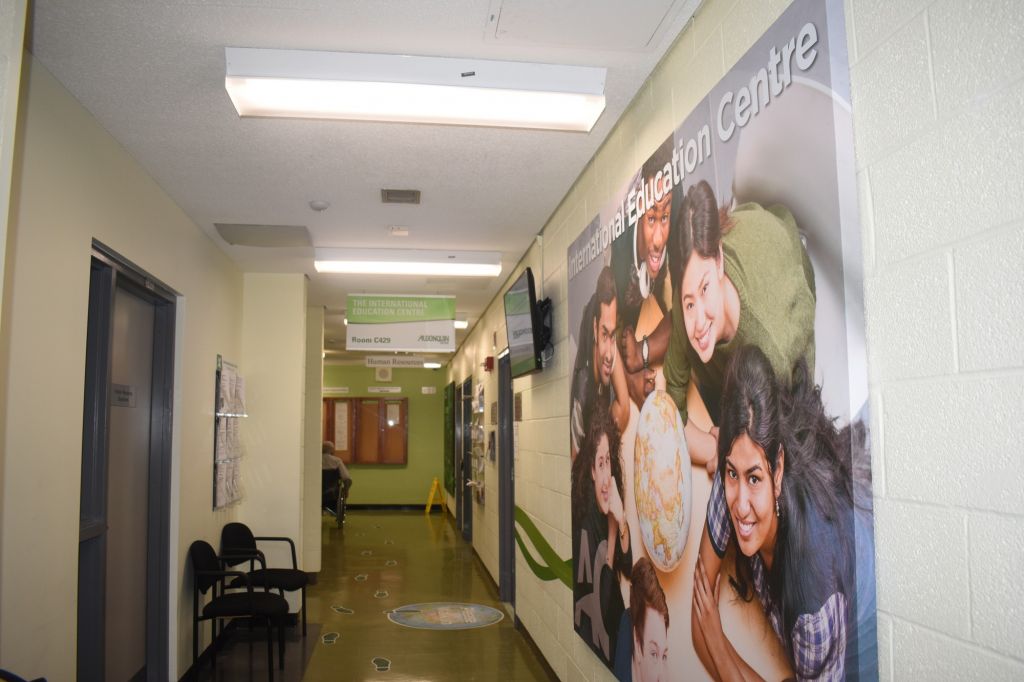A growing number of international students are choosing Canadian post-secondary institutions and that trend is showing up at Algonquin.
At the moment there are 3,000 international students at the college which make up 14 per cent of the overall enrolment.
International enrolments at Algonquin saw a whopping 39 per cent year-over-year increase and domestic enrolments are also ahead of last year.
The Canadian government has an ambitious plan to increase the number of international students to 450,000 by 2022.
Anna Chahodry, an international students’ integration manager at Algonquin, thinks that Canada has a very good immigration policy that attracts people to come here.
“Canada has a reputation for being safe and it has a welcoming community for people of different cultures,” she said. “Parents feel safe sending their kids to colleges and universities.”
According to the Ontario’s Ministry of Advanced Education and Skills Development policy, international students pay all relevant Canadian fees plus an international premium of $4,825 per term for full-time post-secondary program with regular and high demand tuition fees. As well, there is an international premium of $4,025 per term for full-time graduate certificates and bachelor programs. The premium includes health insurance for full-time students.
Still, the cost is less compared to the other universities abroad: United States, United Kingdom and Australia.
“Our institution is publicly funded for the Canadian students (by the Ontario government) but international students’ families do not pay for the taxes in the country for which they have higher fees,” Chahodry said. “We are cheap compared to the American universities and colleges.”
Algonquin’s top enrolled international students mix is from five different countries: China, 33 per cent, India, 12 per cent, South Korea, 5.8 per cent, France, 5.7 per cent, and Saudi Arabia, 4 per cent.
“We have a lot of diversity,” she said. “It is difficult to get quality education in these countries because of the demand but our colleges and universities are generally of good quality so it becomes easy for the students to attain education.”
She said that Chinese students tell her that in their country it is easy to get into education but difficult to come out with a degree. In Canada, however, it may be difficult to get into an education system because of the credits evaluation, but in the end one has a degree to celebrate.
According to the Times Higher Education news, several universities in the country have reported double-digit rises in international applications to graduate programs since the U.K.’s Brexit vote and the election of Donald Trump as U.S. president.
According to the Canadian Bureau of International Education, international students made up 11.5 per cent of the post-secondary student population in Canada in 2017 as compared to the past year.
However, there were 494,525 international students in Canada at all levels of study in 2017. Of them 48 per cent were in Ontario, 24 per cent were in British Columbia and 12 per cent were in Quebec.
According to the CBIE, 60 per cent of the students receive credit on their Canadian transcript for their most recent experience abroad. But for most of the students, it is a difficult process.
The independent survival in the country leads students to find jobs in Canada.
“International students have a huge economic impact,” Chahodry said.
The CBIE study shows that the presence of international students created over 81,000 jobs and generated over than $445 million in government revenue.
Moreover, Canada derives nearly $8 billion annually from international student expenditures including tuition and living expenses.
“International students are incredibly resilient and are resourceful. Many of them are brave enough to leave their families behind and go for education without having support from their families, and having to adapt to a new culture and a new way of life and work,” Chahodry said. “We give them all the possibilities and options; we tell them positive and negative impacts of all of them and we build their confidence to encourage them to be able to make good decisions.”
According to the CBIE reports, 70 per cent of the program concentration of international students in winter 2017 was in two schools: Technology and Trades, 37 per cent, and Business, 32 per cent. In addition, some schools suited other students: 14 per cent, Hospitality and Tourism, nine per cent, Arts, Media and Design, seven per cent, Health and Public Safety.
“International students are entrepreneurial and their families are basically business-oriented, Chahodry said.
“Many of them come from rapidly developing countries so business is their preference.”
They also recommend Canada to other international students. CBIE studies show that 95 per cent of them recommend Canada as their education destination.
“We need different people to work and they contribute to our society. This makes our college diversity enhanced. Many of our students wouldn’t have travelled around the world so if we have international people, our students can have a view of other cultures and they can get to know the people from different cultures without having travelled those places,” Chahodry said.
The college’s offshore post- secondary program delivery in 2016-2017 was to Manav Rachna international university in India, Hotel Education in Montenegro, and AC Kuwait.


